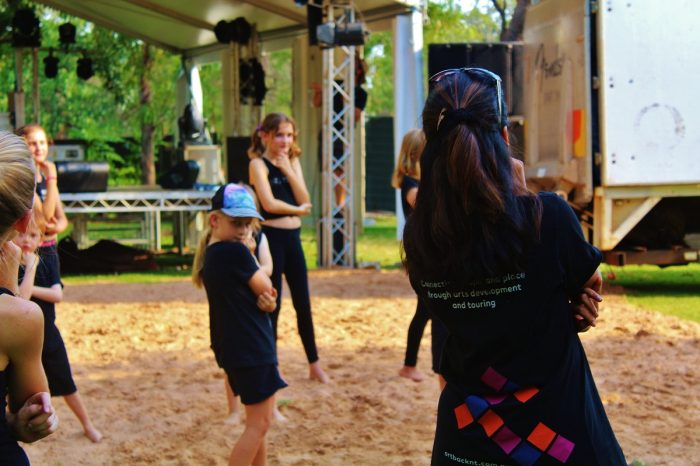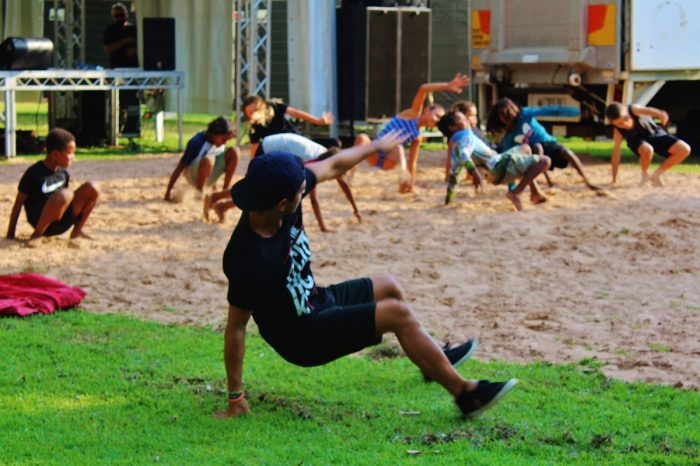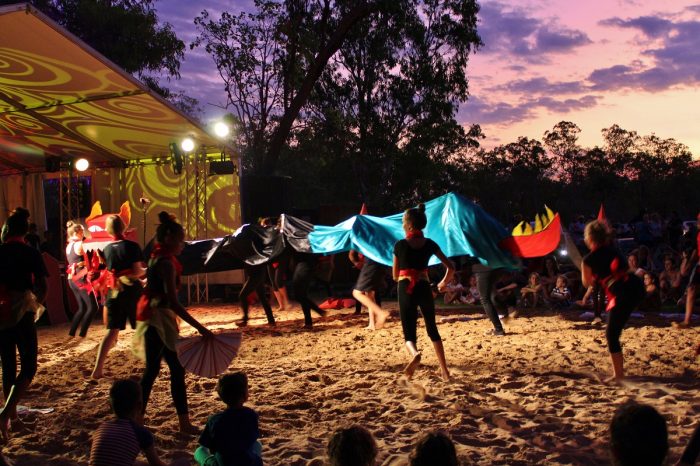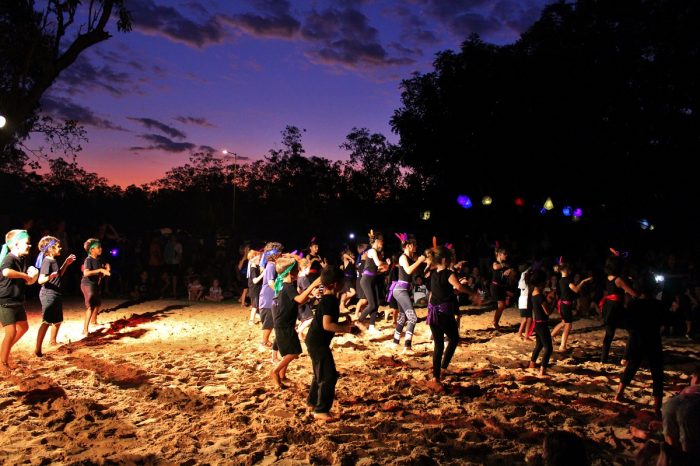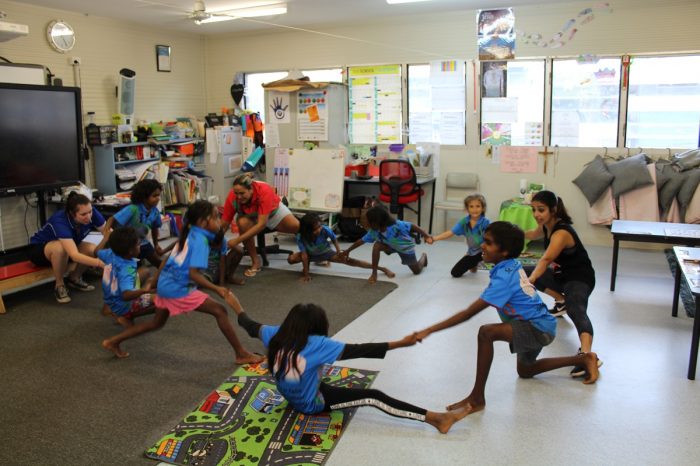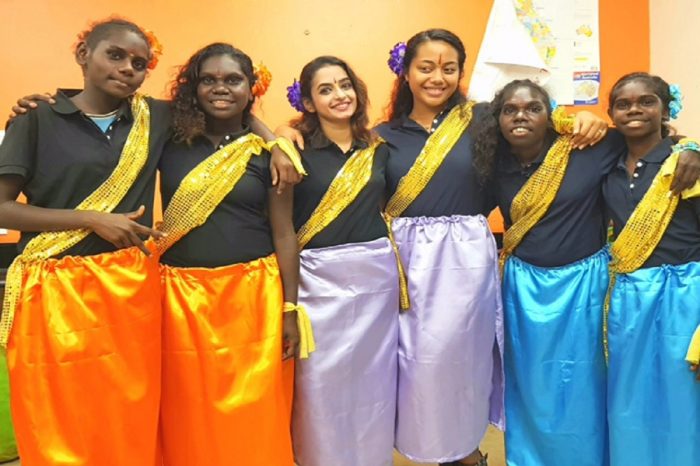Dancing across the Territory… Jinu Mathew reflects on her Artists on Tour workshops

Jinu Mathew is a passionate teacher, psychologist, dancer and choreographer living in Darwin. Director of her own dance school Transwings Dance Studio since 2016, she has been involved in events such as Darwin Festival, Seabreeze Festival, Malandarri Festival – Borroloola and Bak’bididi Festival – Ramingining.
Jinu has delivered dance workshops within our Artists on Tour program for a number of years. Her workshops take you on a journey through different dance forms including Afro-Jazz, Bollywood, Contemporary, Indian Classical, Kathak, Bachata and Soca Caribbean. Here Jinu speaks with our Intern Mia Tinkler about her recent Artists on Tour workshops and the joy of sharing dance across the NT.
Can you begin by telling us a bit about your recent experience at the Mahbilil festival in Jabiru…
Beautiful. One of the best festivals. Borroloola was good but this one was great, because we got more time to teach. I got two weeks in the lead up to the festival. There was another guy with me, a hip-hop dancer, John Rigas. We were getting the kids ready for their opening performance at Mahbilil festival. For the performance we wrote a Chinese dance, mixed with a bit of a snake story, but not their snake, because that would be too close culturally and very sensitive. So we made it a dragon, and danced a Chinese traditional story dance. Within one week together we had almost planned three dances from my group and two dances from Johns’. Another week later we had arranged all the costumes. We cut them all ourselves!
Were these the costumes for the Chinese dance?
Yes, Eve from Artback NT sent all the materials. We got proper materials: purple, black, grey, satin! And satin is the cheapest which is the best, as we can cut it mercilessly (laughter!). So we made costumes for their bodies and heads. For the small girls in the hip hop group we just made a scarf to go around their waist. And the final dress rehearsal was wonderful. It was in the schools big auditorium. More than 52 kids all gathered for the final practice. That was beautiful because they are all dancing together. The fact is, they are so small and within two days practice they had already gotten it! The small kids were the stars! Even John’s hip hop kids, you think they won’t do it because of the shyness, but they were so good!
How do you combat this shyness in the workshops?
Well this time we had the teachers there. When I went to Maningrida, no one was there because it was a school holiday program, it would only be the youth workers and they are busy with their own stuff so they are not always able to come and encourage the kids for us. But this time we got teachers and they are the backbone. So it all depends, one community to another.
Often you’re working in contexts where English may be a third or fourth language, would you also say using movement as a way to communicate is kind of its own language?
Yes I think so! When we have dance and art, we don’t need language. Also I trust there is a big connection between Indian and Aboriginal cultures. That’s where the easy connection is happening. Like shyness, men’s business and women’s business, and skirts (you can’t show the thighs), all of those are very similar with the Indian stuff. Even some attitudes and incidents that I’ve heard from communities, the same things happened in India. Also the elderly people, just like our grandparents in India, you have to respect them. So that might be why it’s easy to relate without language.
Have you worked with kids much before this?
Yes! I was working as a teacher from the age of 18. I started as a tutor and when I finished my masters I enrolled as a lecturer. So with kids, I’m so comfortable and psychology helps me a lot. I studied child psychology at University. That helps me for the therapeutic approach. We could feel what’s happening with the kids and know how to approach it.
My therapeutic approach is that every time we dance we start off with yoga, it helps me to maintain the energy in the class throughout that one hour. Then we do Zumba and Soca Fit, which I learnt in St Lucia in the Caribbean, this maintains the attention and concentration throughout the group. And then there’s Bolly Fit. Which is like Bollywood dance with Zumba. That’s just a happy one, easy but funny. So once the music starts we are all right there, in it together. And then we end with 5-10 minutes of meditation. You can just feel the difference. Out of 20 kids, maybe 18 follow till the end. Because you can pull up their concentration throughout, you can be the leader. It’s a slow process but a systematic process too. It’s exactly like a therapy. I’m working as a councillor in Carpentaria with CADS (Community Alcohol and Drug Services), doing yoga and therapy, and even there it works.
It sounds like it’s so beneficial to be able to draw on all these different skills as part of your process.
Yes, in all aspects. Not only physically and mentally, but socially and spiritually, too.
Do you find that these workshops inform your own practice? Do you bring anything out of that space for yourself?
Well I was a dancer staggered from the age of 3 years. I was working as a professional choreographer from the age of 19 for a while in Europe. Then I started my masters, and went to St Lucia. I enrolled as a psychologist and a lecturer. But those days I was missing dance, I gained weight and I got pain back. So I started again, and it all came back. Then when I came to Darwin, I really want to choose dance in a therapeutic way, because of my nursing and psychology background. Because I haven’t seen many psychologists that dance, or nurses that dance. So I was thinking how can I mix dance and therapy? How can I provide help for the public or awareness for the society? Because if I just perform dance it’s only for the audience to watch, but if I can make them dance, it will have a much bigger affect. But at that time I didn’t know about working in communities, or with Artback NT.
One example of this impact is Angelina, from Ramingining. I had been to the community before for workshops with her. And she really trusted and believed that I will be coming back and that we will dance together. She ordered costumes, accessories, everything. I didn’t know about it at all! As soon as I arrived, she asked ‘when are we going to dance?’ I was so happy. I had been doing workshops with the kids all week and on the Friday night she came to see me at my house and asked ‘is it okay that I join you for the dance performance?’ I said ‘yes of course, but do you know any of the dances?’. Well, she had remembered the song from the last time Artback sent me there and she said ‘can we dance to that song?’ And we danced! I can’t say it was a professional performance but it was beautiful! I learnt later that was the first time in the history of Ramingining that a girl from the community had danced on the stage. Their stage is the sand. It was the first time.
That’s an amazing space to have created.
Yes exactly, and that night was amazing, everyone was surprised! No one knew she had been dancing! Because when you look from the outside she is so shy, but she was so comfortable with me and my approach. Because that was the third time I had visited Ramingining and when you return to a community people know you by your name. That’s very, very important. And the girls are always the hidden talents. Because the boys get chances. They are always doing hip-hop, freestyle, and sand dance. But the girls and ladies… well Angelina is a great example. She even cried, the first time on stage. And her Dad and family, they were all supportive. Sometimes the families don’t support that. It was beautiful.
So these workshops start to shift the way people are thinking about each other and create new possibilities…
Yes! And it’s important we bring stability with us. We need to keep our mood throughout the whole time. That’s how psychology helps me, emotional stability, otherwise you would go down within seconds. We need to keep on track.
Do you have any particular practices throughout the time to maintain that stability for yourself?
You know, if you love your job properly you won’t mind it and if you’re comfortable in the situation it’s okay. You can always simplify the issue. You just remember you’re not going to be doing that all day, it’s just an hour or half an hour. And you will make people happy. Just look for that otherwise you could spoil your whole mood, or your day, or your job! If you’re thinking it’s just about money, you might feel like that. But if it’s something different for you, then you won’t feel like that. If you love something it’s very easy.
That’s a beautiful premise.
Yeah, and they are very talented. I’m teaching in all kinds of schools here in Darwin, and you can feel the difference. Out in community the kids are very strong and they are born dancers. And if they get enough training they will be leaders in the art sector, in dance and music and the health sector. They are just not getting enough training, preparation or money. They are very talented. The Chinese dance in Jabiru was the greatest example, every day practising Monday to Friday and the performance was amazing.
Artback NT’s Artists on Tour initiative brings together leading artists from across the Territory to deliver creative workshops in schools and communities around the NT. Supporting the development of emerging and established artists, young people and the community within their regional and remote location, Artists on Tour is an exciting offering and one we’re proud to make possible. Want Artists on Tour to run workshops with your school or community group? Get in touch!

